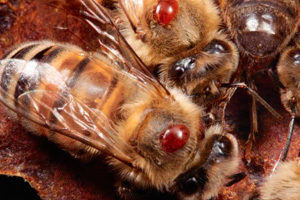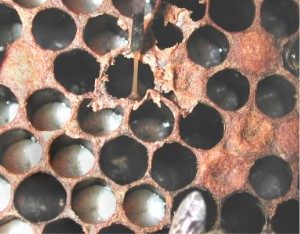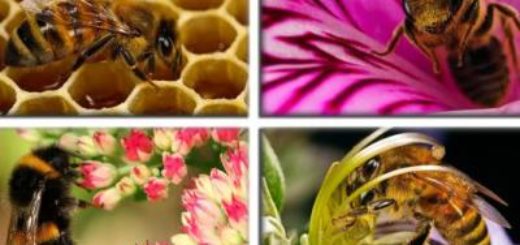Bee brood diseases

Bee brood diseases: foulbrood, askosferoz, varroatoz.
Etiology
Diseases brood – a group of diseases of bees, which exposed young individuals in the first three stages of development: eggs, larvae and pupae.
 Brood in the first two stages – eggs and larvae – called open, and after, to be open wax caps – sealing,.
Brood in the first two stages – eggs and larvae – called open, and after, to be open wax caps – sealing,.
Healthy brood in a designated area for a cell is usually the same age, at the stage of eggs and larvae of white color and has a shiny, wet surface oilily.
Pechatanyy brood also has its characteristic features.
Cap cells at first light and transparent, uniform and have no defects.
Then underneath the center there is a dark spot – developing bee. All other features, different from the norm, talk about the disease.
They are quite easy because of the visual inspection of bee brood combs.
In infected eggs, larvae and pupae stops growth and development, they lose luster, gradually darken, emit a characteristic foul odor.
In the first phase pechatanoho brood visible disease symptoms may serve deformation flip-off caps, their excessive perforation, discoloration.
As open, and closed brood bees periodically review the beekeeper needs in terms of normal or abnormal flow of young insects.
To remove the audit cover ceiling hive and, then push towards the extreme honeycomb.
Then one by one removed cell medium, which usually busy brood and carefully consider their, returning them to the bottom side of the sun, be well seen the bottoms of cells and their bottom wall.
When viewed Particularly noteworthy empty cells, depressed, perforated lids and darkened larvae have changed.
If the brood is healthy and not suffering illnesses, empty cells detected minimum number, because uterus not sow eggs properly constructed cell.
In the event of the death of the larvae of various bee diseases empty cells are much more, as a brood or bees removed, or dry and dark, had become prominent in cells.
To properly diagnose disease, damaged brood frames need to carefully examine.
It should be borne insects age, their location in the cell, color, appearance, the absence or presence of the characteristic odor of the hive.
Classification of diseases
Larvae and pupae, as adult bees, prone to various diseases.
Infection pathogens are viruses, microbes, spore-bearing mushrooms, which, while in the body of the larvae, there are parasitic organism poison toxic waste his life.
Many of these diseases are highly contagious degree.
Sometimes it is enough to get infected with at least one larva, so soon from her disease has spread to the whole brood. .
His death preclude renewal of the family, from which it is reduced and may eventually die too.
All diseases, which can be subjected to bee brood, divided into infectious and non-communicable. If you do not take timely action, Even from such a problem can get family and the entire apiary.
The group include contagious infectious and parasitic diseases:
- American foulbrood;
- European foulbrood;
- parahnylets;
- mishotchatyy brood;
- askosferoz;
- aspergillosis (stone brood);
- varroatoz.
Infectious diseases have the following characteristics:
American foulbrood (She threw larvae)
Struck sealed brood. It becomes colorful appearance. Printing concave, perforating. Gray-brown larvae patients, pupa early age are at the bottom of cells. They stick to the head cap cells.
European foulbrood (Stryeptokok Apіs, pluton bacteria, Pluto and strep bacillus Alva)
Struck open brood, sometimes a printed. Yellowish-brown larvae are softened and the bottom cell in a bent form, easily be separated from its walls
saccular brood (dry foulbrood) Вірус delayed youthful. (SBV)
Suffering open brood. Dark brown larvae are curved at the bottom of the cell, take the form of bag, filled with liquid
Askosferoz (lime brood) Гриб Ascosphera apis
Suffering is open and a printed brood, preferably drone. Dead larvae are hard to the touch, dried, covered with white fungal mycelium. Looks like pieces of chalk.
Parahnylets (She threw paraalʹvej)
Struck sealed brood bees. It becomes red-brown, doughy consistency, well separated from the walls.
aspergillosis (stone brood) Fungi of the genus Aspergillus
Brood covered with gray mold and shrink, then become solid, yellow-green or black color, Recalling the form of pebbles
Invasive disease are just one illness:
Varroatoz (varroa mite)
Affected bee larvae and drones. Parasites feed on insect hemolymph young, that kill or leave them weak underdeveloped bees.
Non-communicable diseases of bees
Non-communicable diseases bee brood developing as a result of violation of the rules and conditions of bee colonies, their feeding and breeding.
They disappear quickly after, as the cause of their appearance will be detected and corrected. These diseases are not contagious, ie moving from infected to healthy and insects do not apply between apiaries.
They can be described as follows:
a cold brood
Prolonged or severe cooling slot. Brood dark colored liquid consistency, sometimes turns a dark brown mummy. It may be the smell of hydrogen sulfide.
Genetic mortality (missed first trimester abortion or motley brood)
Heredity. The close mating and breeding uterus and drones. Pupae are affected in the last stages of development. They are soft and moist, slightly viscous. First siriyut, and then dry out and become dark brown.
fodder toxicosis (chemical and valleys)
Poisoning by pesticides, applicable for processing posiviv.Otruyennya honeydew honey: Because the larvae eating toxic food, they violated the digestive tract and then they die.
protein deficiency
Lack of Perge and pollen. larvae, receiving poor protein feed, far behind in development. Young birds, emerged from this brood, viable and die at an early age.
Dry sowing
Invalid care. In some cells around hundred larvae feed there lychynochnoho.
Treatment of diseases brood
If you find any bee disease should as soon as possible to begin the implementation of remedial measures.
As should be treated bees:
- Patients with family, however as healthy, be treated with medicines least twice.
- During the course of medicines to be changed, as in this case, treatment becomes more effective.
- Not flying and rainy weather is no exception for the health work.
- During treatment of infections and infestations should be updated slot, removing frames of brood patients, empty and too filled with honey.
- All bdzholosim'yi encouraged to move into empty new or disinfected hives.
- Handle not only the frame, but inside the hive.
- After about a week of displaced families need to pick up the framework and process them himpreparatamy, and wax peretopyty.
- Replace the old to the new womb, preferably thoroughbred.
- Heavily infected brood eliminate.
- Family recovering feed.
disease prevention
As you know, better to prevent disease, than to cure. This is true in relation to bee diseases.
To safely stop their appearance in the apiary and further development, necessary to make such precautions:
- keep strong bee families with young productive purebred sows;
- bad uterus prematurely replace;
- provide timely benign bees forage in the required amount;
- eliminate weak, who often get sick and can not tolerate the winter family;
- periodically weed cells and used them to wax peretoplyuvaty; insulate the hives for the winter;
- prevent them from overheating and overcooling;
- install hives at some distance from each other, paint them in bright colors (mainly yellow and blue), to prevent wandering and stealing bees;
- observe cleanliness in the territory of the apiary, do not leave anywhere bits of wax, propolis, clean up spilled honey;
- carry out preventive feeding;
- replace a drinking stagnant water on fresh; mechanically clean the hives and then disinfect them.
The timely disease prevention brood – is key to the health of bee colonies, their high fertility, performance and great quality merchandise returns chalk. So it is in the interest of the beekeeper.
Video




6 Responses
[…] resistant to invasive disease. Example, under unfavorable conditions and overwintering […]
[…] askosferoz; […]
[…] such as nozematoz, Septicemia, colibacteriosis, foulbrood etc.. Tips for beginners: home treatment […]
[…] — immediate removal of the infected hives framework with infected brood and his […]
[…] rates of productivity, hardiness, disease resistance, peace and neroylyvosti. Such bdzholosim'yi […]
[…] degree contribute to weakening bees and disease development, a combination of several of them increases the risk of outbreaks […]